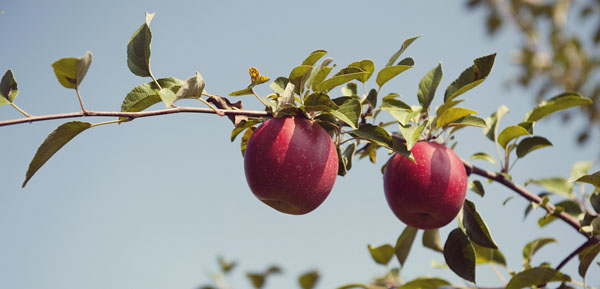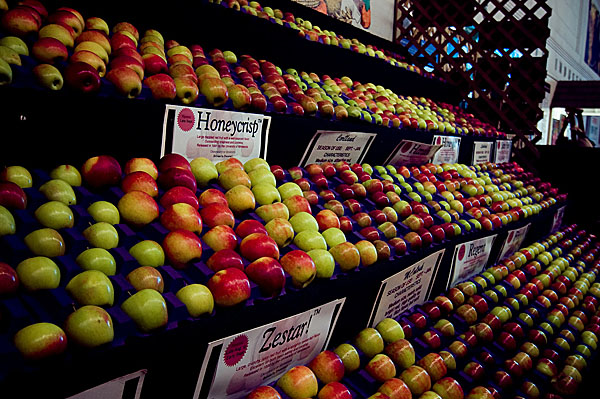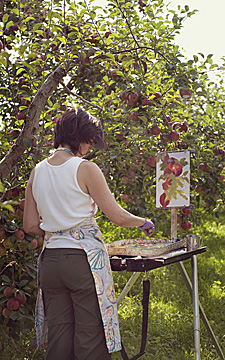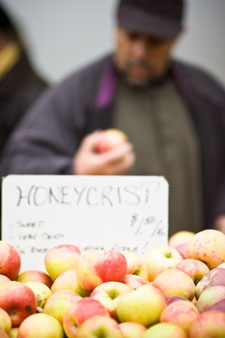
The introduction of the University of Minnesota’s newest apple varietal, the SweeTango, garnered significant attention during its limited release this fall. “Every customer asked about it,” said Max Maddaus of the St. Paul Kowalski’s produce department. “As soon as we filled the bin we sold out. We’d get a new shipment in, and it would sell out again.” Local consumers were well aware of the University of Minnesota’s newest apple brand, an offspring of Honeycrisp (above) and Zestar parents, and were eager to try it themselves.
“We wanted the good crisp of Honeycrisp, and the juicy flavor of Zestar,” says Jim Luby, a professor of Horticulture at the University of Minnesota and one of the developers behind SweeTango and the University’s reigning queen, the Honeycrisp. “It’s a little denser and firmer, and breaks off into chunks.” The introduction of the two parents was very much planned by design. (Not unlike the Honeycrisp itself, the golden child of the Macoun apple of New York and Honeygold of Minnesota).
The buzz around the SweeTango reminds us of one of the apple’s most unique selling points. Unlike its produce department neighbors, like a raspberry or a tomato, there seems to be an infinite number of apple varietals, ripe for your eating pleasure. Sure, there are a handful of branded fruits that are somewhat comparable; Bosc pears, Florida oranges, Colorado peaches. But none of these fruits compares to the apple. There’s Pink Lady from Australia, Fuji from Japan, McIntosh from New York, and the locally spawned Honeycrisp. The list goes on and on. In fact, there are more than 7,500 apple varietals available worldwide.

Building an Apple
The University of Minnesota is certainly not new to the world of apple development. Their program has been in place for more than 100 years. During this time, they’ve released nearly 30 varietals. The school is home to one of only three apple breeding facilities in the country, and has a strong reputation for releasing hearty varietals that can withstand cold winter temperatures. Apples are a perfect match for Minnesota weather. On the tree, they can survive temperatures as low as 25 degrees. Thanks to their high sugar content, they won’t freeze.
The turnaround time behind the development of a new apple varietal certainly isn’t quick. The period between when the two parents are crossed and when the apple is available to the public can span 20 years. “There’s no timetable on developing new apples,” says Luby. “They come on their own schedule.” The cross for the SweeTango was made in 1988. Although both parents were success stories, matching them did not guarantee a victory. Apples are like humans. One can grow anywhere from 50 to 100 offspring from one set of parents, but they aren’t all the same. “Even though you might have the same parents as your sibling,” says Luby, “the two of you are not exactly alike.”

The next step is finding the gem among siblings, if one exists. Over a period of three to eight years, Luby and his team will weed out the best of the best among offspring, discarding the trees that aren’t hearty enough to survive winter weather. This period is known as the juvenile phase, as the apple trees are physiologically incapable of flowering and producing fruits. “The tree gets big, strong, has some reserves, before it puts a lot of energy into making sweet apples,” says Luby.
Once they bear something edible, the fruit is tasted and either thrown out or chosen to move on to the next step. Only one or two trees out of every hundred make it past the initial stage. The “chosen ones” are cloned through a grafting process. Leafy stems from the desired tree are joined with dwarf rootstock and given a number. SweeTango’s label was MN 1914.
The grafted trees take another three to eight years to produce fruit. Once this second growth period is over, the new cross is sent to growers throughout the state and country in order to find out how well it can adapt to different locations. The trees also need to be checked for viruses. By this time, they’ve been in the fields for 10 to 15 years, and it’s possible they picked something up. If a virus is located, heat therapy is used to eradicate it. This process tacks on another one to two years.
Then, names are discussed, and paperwork for patent filing begins. In the United States, fruit patents last 20 years. (The recently expired Honeycrisp patent ended in 2008.) The University’s office of Technology Commercialization lines up potential licensees of the new apple breed, and puts out a bid to decide who will partake in distributing the new apple.
Selling the Brand
So if apple development and branding has been around for so long, what’s the big deal with the SweeTango? Well of course, it’s new. People want to try something new. Lately, water cooler talk has welcomed the topic of apples and the elusive SweeTango. Who’s tried it? What did they think? Better than the Honeycrisp?

Aside from the newness, what’s most interesting and different about the SweeTango is the strategy behind the apple’s growth and distribution. Unlike the Honeycrisp (which was fitted for an open release by the University via 20 different nurseries throughout the country), the SweeTango is a managed varietal available only through the Next Big Thing, a growers’ cooperative headed by Pepin Heights Orchard in Lake City. What does this mean? The SweeTango will be available in lesser quantities for a shorter period of time.
Next Big Thing Growers’ Cooperative comprises 45 growers throughout the United States and Canada. “We have growers in Minnesota, Washington, Michigan, New York, and Nova Scotia. All climates that are conducive to this apple,” says Tim Byrne, President of Next Big Thing and Vice President of Sales and Marketing for Pepin Heights. It’s part of a new and increasingly popular concept in the United States, the “managed apple variety.”
“By managing an apple, you get to determine the best sites to grow it, the amount of product you bring to market, and the quality standards you want that trademark to bear,” says Byrne. This strategy has been used in Europe for years. One of the frustrations behind Honeycrisp’s open release was that the brand was slowly diminishing. One could grow the apple in any climate, without regard to whether or not it was suitable for the apple. They could also be distributed too early in the season.
“People want to see an open release, but the ultimate fate is that the quality of the apple is no longer controlled. I’m not pointing fingers at the growers. The market rewards the growers who produce the first apples, and often times you’ll see a product in the marketplace too early. The disservice goes to the consumer, who purchases the product.” To prove his point, Byrne pulls out two apples; a green, unripened Honeycrisp, and a half-green, half-red SweeTango. “Is this something you’d like to buy?”
Buying quality comes with a cost, and this year’s SweeTango release was slightly more costly than its Honeycrisp successor. According to Byrne, the SweeTangos packed and sold by Pepin Heights were priced at a ten percent premium over Honeycrisp. At the same time, the first round of Honeycrisp apples sold in Washington were priced higher than the SweeTangos sold here. Next Big Thing is open to price changes in the years to come. “Consumers tell us what is fair value for the products purchased. SweeTango is not immune to competitive varieties, of which there surely will be more in the coming years,” says Byrne.

Really, apples are not any different than any other non-food products in the marketplace. Their success depends on brand loyalty. Just as you might buy an Apple computer for its friendly user capabilities, you can also purchase an apple to eat because of the juiciness or tart aftertaste. Byrne hopes that managed varieties will encourage consumers to anticipate seasonal tastes. Providing different tastes to satisfy every apple-eater’s preferences is a critical objective behind apple breeding and branding. “Remember when you were in grade school, and got that little Red Delicious and it was bland and mealy? That’s what we give our kids. We’re not providing good fruit for them,” he says.
Byrne references the huge differences in apple consumption between the United States and Europe. “On average, we eat 18 pounds of fresh apples a year. Europeans eat more than double that.” He likens the difference to the higher number of fresh, seasonal varietals available in European countries. “When a food is available year round it becomes boring. I think we, as an apple industry, have done this to ourselves. We want better products for a shorter period of time. The product is fresh and creates excitement for the consumer.”
For the time being, membership is capped for joining Next Big Thing. They’ll wait five to six years before they decide whether or not to increase. Byrne says they need to see what the consumer response is in the market. “There was no owner’s manual for Honeycrisp. There isn’t one for SweeTango. It’s all a risk.”
Mixed Reactions
This new distribution strategy has elicited some frustrated responses from local growers. Unlike the Honeycrisp, where one could buy a tree by simply paying a one-time fee to the University, all SweeTango purchases must be made through Next Big Thing and Pepin Heights Orchard. Also, the fee has changed to a royalty per year per tree.

Growers are required to sign a lengthy contract, specifying where and how the trees can be planted and how they can be advertised. They are also limited in the number of trees they can plant. Any grower in the state of Minnesota can purchase up to 1,000 Minneiska trees (the type that bear SweeTango fruits). But according to some local growers, this doesn’t amount to much.
Another difference between the distribution of the Honeycrisp and that of the SweeTango lies in how a grower is allowed to sell them. Only members of the cooperative are licensed to sell the SweeTango apple commercially, meaning to grocers. Those outside the cooperative can sell their fruits privately via farmers markets and farm stands. If you’re a grower outside of Minnesota, and you’re not part of the cooperative, well, then you’ll need to find another apple. Minneiska trees are not available for standard purchase outside the state.
“I thought everyone would have to follow these rules,” says Aaron Peterson of Sever’s Farm, a local grower with a primary concentration in sweet corn. With an interest in adding apples to their line of produce, and upon the recommendation of an apple researcher, Peterson decided to plant 200 Minneiska trees last spring. He was excited about adding the novelty of an apple orchard to the farm, and thought consumers would be driving to farms to find the SweeTango. This fall, Peterson was surprised to find SweeTango apples available at his neighborhood grocery.
The argument against this distribution revolves around the University of Minnesota being a public land-grant school. The mission behind the land-grant system is to provide the public with knowledge gained through research methods (such as the new apples being born out of the fruit-breeding program). University funding comes from local county taxes, as well as federal and state appropriations. Any additional financial support comes via other routes. This was the case with the Honeycrisp apple, which earned more than $6 million. One third of that went back to the fruit-breeding program, another to a general research fund at the school, and the third to the breed’s inventors.
Although the University is predominantly a publicly funded organization, its operations are not unlike that of a regular business. Much like how the producer of your favorite brand of cereal needs you to buy a box to continue packaging it, the fruit-breeding program at the school needs funding to support it and keep Minnesota amongst the leaders of the apple pack. Prior to last year, the Honeycrisp patent was the major breadwinner, but because of last year’s patent expiration, the program needs a new honey pot to find funds.
So, apples are proving to be similar to any other product in the marketplace. This year the SweeTango relied heavily on the simple economics of supply and demand. Some argue that the new distribution is pushing to keep supply down in order to keep the demand up. After the SweeTango’s premiere this fall, questions are being raised as to whether or not the limited distribution is fair, as the SweeTango is a product of public support and funding.
Do the apples keep getting better?
At the end of the day, new apple varietals come out every year. The buzz around a new apple is no different to that of a new restaurant, or even a phone, or a car. The novelty is exhilarating at first, but a natural cycle is sure to follow and that initial excitement eventually wears off. As time goes on, you’ll find yourself loyal to the apples you are partial to, not because they are new, but because they possess the flavors you prefer. Both Luby and Byrne are quick to say the SweeTango isn’t necessarily the best apple out there. It’s just different. SweeTango was an early season varietal, so you’ll have to wait until next year to try one. But don’t forget about all the others.
Some apples are better for eating fresh, while some are fit for cooking. For example, Luby prefers cooking with Zestar. He also likes a good old-fashioned Cortland, a classic varietal that’s been around for more than 100 years. Haralson and McIntosh are known to hold their shape during baking, making them perfect for apple pies and crisps. New doesn’t necessarily mean “best.” Go out and find your apple — there are many to choose from.

I loved the new SweeTango! My mouth is watering just reading about them! They were so crisp and sweet; great for lunchtime snacking. I can’t wait to get more next year.
“New doesn’t necessarily mean “best.” Go out and find your apple — there are many to choose from.”
Can this be bolded and inserted at the top of the article as well? I’m kidding, but boy, I hate to see useful, tasty, old varieties get passed by simply because there’s a new kid on the block.
Thanks for this article.
Kathy, I totally agree– I love Cortlands and it crushes me when people refer to them as ‘good baking apples’ and leave it at that. I may have already whined about this online so I won’t go on..but after growing up in upstate NY where we would go apple picking every fall, I love the apples that have that wonderful sweet/tart ‘off the tree’ flavor that just doesn’t stay around when they are in storage.I’ve been buying Sweet Sixteens and Cortlands from Havlicek Orchards at the Kingfield Market, yum!
And been visiting upstate NY this week and saw a new one called Fortune that was good (new to me)
There really are differences, not only between different apple varieties but within the same variety, as well.
While the SweeTango has been getting the attention this fall, Pepin Heights continues to sell a lot of its high-quality HoneyCrisp. I did a blind sampling for them, asking people to choose between a Pepin Heights HoneyCrisp and one from a non-Minnesota grower, and people chose Pepin Heights 27 to 2.
To me, that illustrates one of the points of Alyssa’s article: there’s very inconsistent quality among the HoneyCrisp in the marketplace. You can go to a major grocery chain, pay a premium price of $2.99 a pound, and still not be certain you’re getting an excellent HoneyCrisp.
I would argue, then, that branding will become more important in the fruit category. When people have gotten a few disappointing generic varietal apples, they’re going to start looking for a specific brand label like Pepin Heights, the same way they might look for a favortie vineyard label when buying a bottle of wine.
John, I am in agreement with you about the disparity in the quality of HoneyCrisps. SuperTarget typically gets their HoneyCrisps from somewhere in Washington State and in my experience, they aren’t very good. I wait to buy them at Kowalski’s or Lunds where I know I’m getting the Peppin Heights ones.
I’m glad they are being more restrictive with the SweeTango brand. Quality should remain quite high.
Faith, funny you mention Cortlands — I bought a peck of them this weekend in Door County, and I have been steadily eating them just as they are! So delicious. I also picked up some windfallen, Wisconsin-grown MacIntoshes this week, and I have some older apples of unknown variety from friends hanging around, too. I’ll make sauce of the latter combined with the others for flavor.
I love apple season. Anyone see the recent article in Saveur magazine about apples? Magnificent.
I am a SweeTango Fan. My husband bought some in Door County and WOW they are fantastic!!! I also LOVE the honeycrisp!! I am disappointed when the honeycrisp are gone for the year and now will be when SweeTango is also!! I like my corts and macs to cook with but to have and apple to eat for lunch there is nothing better than these new varieties. The crispness and sweet/tart flavor is wonderful!! I just can’t get enough!! Nothing like going to an apple orchard and picking a honeycrisp right off the tree and enjoying!!!!!!!!!
A lot of the growers who signed the Sweet Tango contract and those like myself who have held back have some serious reservations about the wholesale restrictions surrounding the SweetTango apple.
In a nutshell Pepin Heights has a stranglehold on the whole distribution. Some of us wonder how fair this is considering their size and reach and the fact that state tax dollars were used to develop the apple. I would expect further revisions to the “club apple” agreement coming from our state legislature as the level of unhappiness is rather high in some circles.
To the bloggers and journalists out there I think this is an interesting part of the Tango story that is not getting much coverage.
Kathy where did you buy wind fall Macs ? Its orchards like this that RUIN a good quality apple by selling brused and ecoli ridden apples
Overshadowed by the SweeTango marketing blitz, the other U of MN release of recent past is the SnowSweet. It shares genetics with Honeycrisp and was conventionally released about the same time as SweeTango. Both varieties are too new to yield much marketable fruit yet but keep your eyes open next year for it. If you like Honeycrisp you will probably like SnowSweet too. I like SnowSweet a bit better.
There is too much hype about this apple. They are not as crisp as HC and not as much flavor. My family will take the HC any day over the SweeTango.
I Love these apples they are much better than Honey Crisp and I love them too but Tango’s are much sweeter I have purchased them twice now and will all fall as long as I can get them
Thank you for this excellent article. I’ve incorporated some of the information into an Ask Patents post on Open Release apple varieties.